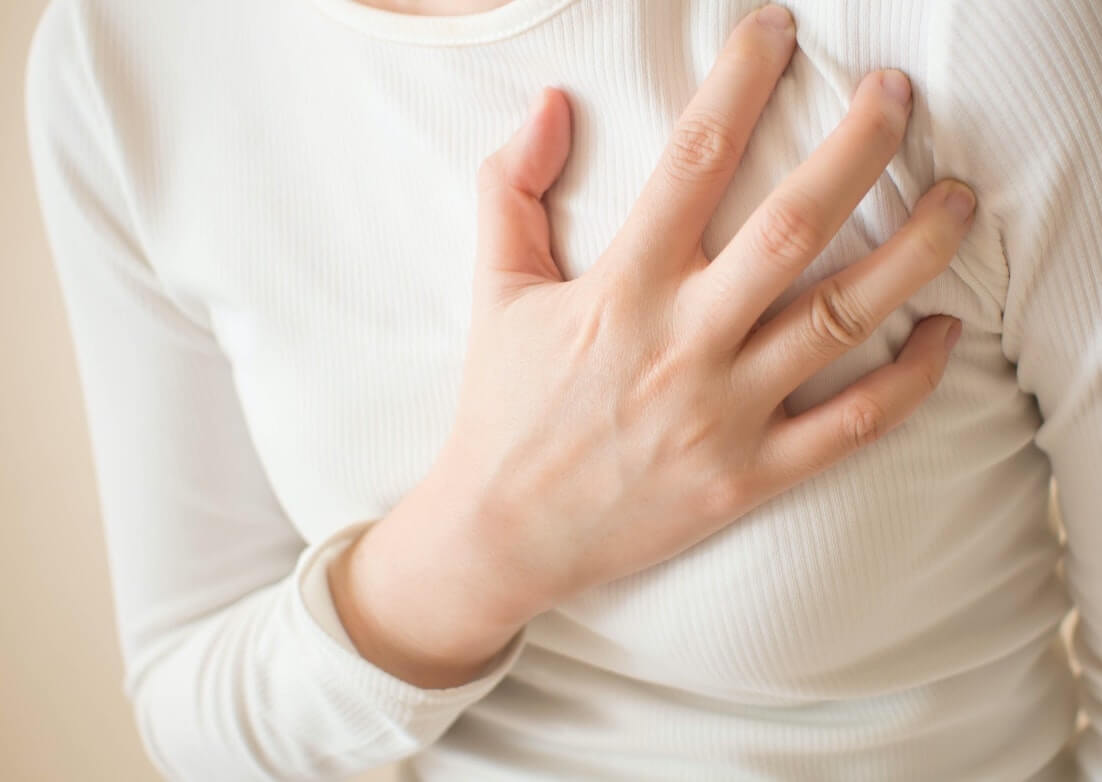Breast Health
Early Signs of Breast Cancer You Should Watch Out for
Medically reviewed by Dr. Tan Chuan Chien

What Is Breast Cancer?
Breast cancer is caused by the abnormal growth of cells in the breast. Cells in our body will normally divide and replicate for growth and renewal. This process is usually well-regulated and controlled by our body.
Sometimes, an error occurs during the replication process and these new cells become abnormal. An abnormal cell may acquire errors (mutations), allowing them to replicate beyond the body’s control. With more mutations, it will eventually gain the ability to spread (metastasize). This ability to spread is what makes a cell cancerous.
The majority of breast cancers start in the milk ducts. Once it becomes cancer, it can spread to the lymph nodes in the underarms, bones, lungs, and liver. Breast cancer can occur in both men and women but happens far more commonly in women.
According to the Singapore Cancer Society, breast cancer is the most common cause of cancer among Singaporean women. In fact, about 6 women are diagnosed with breast cancer every day.
Types and Early Symptoms of Breast Cancer
Types of Breast Cancer
Breast cancer can be divided into two broad categories: Invasive cancer and precancerous (In situ) cancer.
Breast cancer is invasive when it has gained the ability to invade into adjacent organs and spread to distant sites (metastasis). However, normal breast cells do not change to invasive cancer overnight. It begins by acquiring mutations that make it abnormal, and over time with more mutations and abnormalities, it eventually becomes invasive cancer. Before it acquires this ability to invade, these abnormal breast cells are precancerous ie. Insitu disease.
Doctors and pathologists are able to identify and differentiate different types of breast cancers based on how they look under the microscope. This will enable the breast cancer specialist to predict the behaviour for each type of these cancers, and more importantly tailor-suit the appropriate treatment for each individual patient.
The most common types of breast cancers are Invasive Ductal carcinoma and Invasive Lobular carcinoma while the most common type of precancerous disease is Ductal Carcinoma In Situ (DCIS).
Apart from the microscopic appearance of these abnormal cells, a breast cancer specialist can also predict behaviour and outcomes based on different ways which the cancer presents itself. Most cases present itself with a breast lump or are detected through breast screening. However, less common types of presentations include Paget’s Disease of the breast and inflammatory breast cancer.
Depending on the type of cancer you’re diagnosed with, your treatment options will vary.
Early Symptoms of Breast Cancer
While breast cancer can have various symptoms for different people, some patients will not notice signs at all.
The most commonly reported symptom is a lump forming in your breast or armpit region. Other early warning indicators include:
- A painless lump forming in your breast or underarm. This is usually big enough to be visible and does not go away.
- Swelling in your armpit region or near your collarbone. This may imply that breast cancer has metastasized to the lymph nodes, which could result in swelling.
- Pain and tenderness. Although lumps typically do not hurt, some of them may cause a prickly sensation when touched.
- A nipple that becomes pulled inward or retracted. Sometimes, this could be due to a tumour that is not physically visible from the outside.
- Changes to your skin around the breast area. This includes differences in the size, contour, texture, or feeling warm at your breast.
- Unusual discharge coming from your nipple. This may be clear, bloody, or yellowish.
Who Is at Risk?
Unfortunately, breast cancer is a common disease among women. In Singapore, breast cancer is the most common cancer among women, where about 1 in 10-12 women will develop breast cancer in their lifetime.
Understanding your own risk is important because it helps you take a more proactive role in getting this disease treated early or preventing this disease. We can classify risk factors into modifiable and non-modifiable risk factors. Non-modifiable risk factors are things we cannot change such as family history and gender. Modifiable risk factors are things we can change to reduce the risk of developing breast cancer, such as obesity.
Nevertheless, a good number of women who become diagnosed with breast cancer have no known risk factors, besides being female.
Factors that are linked to an increased risk of breast cancer include:
- Sex. Statistically, women are more likely than men to get breast cancer.
- Age. The risk of breast cancer increases with age.
- Personal history of breast conditions. If you have undergone a breast biopsy which detected the presence of lobular carcinoma in situ (LCIS) or atypical hyperplasia of the breast, your risk of breast cancer is higher.
- Family history of breast cancer. If your mother, sister, or auntie was diagnosed with breast cancer, especially at a young age, then you are at a higher risk of developing breast cancer yourself. This may be due to certain genes such as an abnormal form of BRCA1 and BRCA2 which greatly increases a woman’s lifetime risk of breast cancer.
- Exposure to radiation. Extensive radiation treatment to your chest area as a child or teenager can also increase your risk of breast cancer.
- Reproductive history. Early and prolonged exposure to oestrogen increases your risk of breast cancer. This can happen due to beginning your period at a younger age, not having children after the age of 35, or having menopause at an older age.
- Use of hormone pills. Oestrogen and progesterone pills may increase your risk of developing cancer. Oral contraceptive pill usage, especially in your adolescent years, may predispose you to develop breast cancer.
- Obesity. Being obese increases your risk of breast cancer.
- Alcohol. Drinking excessive alcohol can increase your risk of breast cancer as well.
What Is Breast Cancer Screening?
Breast cancer screening involves checking your breasts for cancer before any signs or symptoms begin to show. While screening alone cannot prevent breast cancer, the goal is to detect breast cancer in its early stages, where chances of successful and simpler treatment are higher.
It is important for you to talk to your doctor and find out which breast cancer screening tests are right for you.
Screening Options
There are a number of screening tests, which include:
- Mammogram. An x-ray of the breast looks at identifying abnormalities within the breast. This is the most common diagnostic test used by doctors to check for the presence of breast cancer. During a mammogram, your doctor will gently compress your breast tissue between two plates and take images from different angles to be examined.
- Breast Magnetic Resonance Imaging (MRI). In some cases, your doctor may also suggest an MRI scan in conjunction with other tests. This is another non-invasive imaging test used to examine breast tissues, and is typically recommended for patients aged 25-30 and in a high risk group. For example, if you carry the BRCA1/BRCA2 genes or have a family history of breast cancer.
- Ultrasound tests. Using sonography, ultrasound waves can help to produce an image of breast tissues. This test is particularly useful in younger women or patients with dense breasts.
- Clinical Breast Exam. Your doctor may conduct a physical examination of your breasts and the skin on your breasts. This includes checking for nipple problems and discharge, as well as lumps on your underarm area.
Screening Recommendations
Given that your risk of developing breast cancer increases with age, the Ministry of Health (MOH) recommends that normal-risk women aged 40-49 should go for yearly mammograms. Those aged 50 and above will require a mammogram every 2 years.
If you have any risk factors or abnormal symptoms, you should speak to your doctor and share any concerns that you may have. Depending on your condition and individual breast cancer risk, you may be advised to undergo frequent mammogram screenings. In most cases, yearly screening is sufficient.
Conclusion
Breast cancer is a common disease among women, but is treatable when detected early. We know that with breast screening, we can find early disease which is associated with simpler treatments and better survival. Regular breast screening is well researched to be associated with a lower chance of death from breast cancer. As no two women are the same, it is also important to discuss with your Breast Cancer Specialist about your individual risk and devise a personalised screening regime that matches your own risk.
According to a report released by the Singapore Cancer Registry in 2017, stage I breast cancer patients have a 5-year survival rate of 90%. Stage II breast cancer patients, on the other hand, have a 5-year survival rate of 80%.
Despite the high incidence of female breast cancer, going for regular screenings is the first step that you can take to protect yourself from the disease. It is also important to conduct breast self-examination on your own to observe any abnormal physical changes to your breast area. A healthy diet and lifestyle will also contribute to lowering your chances of breast cancer.
Make an appointment today for a breast cancer screening at SOG, and get in touch with our breast surgeon for a consultation session.
WHO WE ARE
About SOG Health Pte. Ltd.
Established in 2011, SOG Health Pte. Ltd. (“SOG”) is a leading healthcare service provider dedicated to delivering holistic health and wellness services to the modern family.
With a long and established track record in Singapore providing Obstetrics and Gynaecology (“O&G”) services such as pre-pregnancy counselling, delivery, pregnancy and post-delivery care, the Group has since further expanded its spectrum of healthcare services to include Paediatrics, Dermatology, and Cancer-related General Surgery (Colorectal, Breast & Thyroid).
The Group’s clinics, under its four operating segments of O&G, Paediatrics, Oncology and Dermatology, are strategically located throughout Singapore to provide easy access to its patients.
- Obstetrics
- Gynaecology
- GynaeOncology
- Breast, Thyroid & General Surgery
- Colorectal, Endoscopy & General Surgery
- Dermatology
- Paediatrics
Consult With A Specialist From SOG
Visit one of our specialists today to learn more about your health!
Book An Appointment
Fill up this form and our clinic will get back to you shortly.
For general enquiries, please click here.





